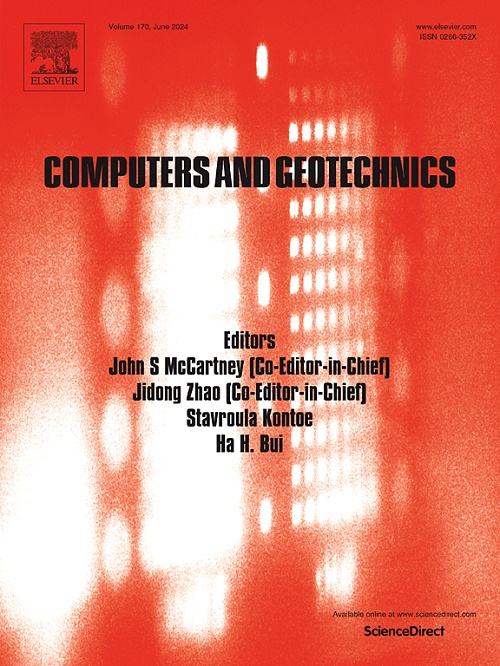Numerical study on seepage-induced instability of soil-rock mixture slopes using CFD-DEM coupling method
IF 5.3
1区 工程技术
Q1 COMPUTER SCIENCE, INTERDISCIPLINARY APPLICATIONS
引用次数: 0
Abstract
Soil-rock mixtures (S-RM) are prevalent in both nature and practice, and stability of S-RM slopes is one of the focuses for engineers. In addition to soil strength, seepage erosion is one of the main factors affecting the stability of S-RM slopes. As water infiltration complicates the multi-field coupling effects and micro-scale mechanical behaviors of S-RM, it is essential to investigate seepage-induced S-RM landslides from both macro and micro perspectives. This study proposed a CFD-DEM fluid–solid coupling method, and the method was validated with Darcy experiments and lab slope stability experiments. The method was then applied to analyze seepage-induced slope instability, focusing on the impact of rock content and rock shape. The results indicate that slope failure under seepage showed the same characteristics as debris flow, with instability features such as sliding surfaces, damage range, and particle motions varying according to rock content and shape. As rock content increased, the accumulation of slope transitions through three distinct modes. Slope was prone to failure along the soil-rock interface, and low rock content further impaired the stability. The slope deformation was primarily driven by changes in particles contact. Once slope instability occurred, the system tended to adjust particle contacts to achieve new state of equilibrium.
基于CFD-DEM耦合方法的土石混合体边坡渗流失稳数值研究
土石混合体在自然界和实践中普遍存在,土石混合体边坡的稳定性一直是工程技术人员关注的焦点之一。除土体强度外,渗流侵蚀也是影响S-RM边坡稳定性的主要因素之一。由于水的入渗使S-RM的多场耦合效应和微观尺度的力学行为复杂化,因此从宏观和微观两个角度研究S-RM滑坡是必要的。本文提出了一种CFD-DEM流固耦合方法,并通过Darcy实验和室内边坡稳定性实验对该方法进行了验证。然后将该方法应用于渗流边坡失稳分析,重点研究岩石含量和岩石形状的影响。结果表明:渗流作用下边坡破坏表现出与泥石流相同的破坏特征,其失稳特征包括滑动面、破坏范围、颗粒运动等随岩石含量和形状的不同而变化。随着岩石含量的增加,边坡的堆积通过三种不同的模式转变。边坡沿土石界面易发生破坏,低含岩量进一步破坏了边坡的稳定性。边坡变形主要是由颗粒接触变化引起的。一旦边坡失稳,系统倾向于调整颗粒接触以达到新的平衡状态。
本文章由计算机程序翻译,如有差异,请以英文原文为准。
求助全文
约1分钟内获得全文
求助全文
来源期刊

Computers and Geotechnics
地学-地球科学综合
CiteScore
9.10
自引率
15.10%
发文量
438
审稿时长
45 days
期刊介绍:
The use of computers is firmly established in geotechnical engineering and continues to grow rapidly in both engineering practice and academe. The development of advanced numerical techniques and constitutive modeling, in conjunction with rapid developments in computer hardware, enables problems to be tackled that were unthinkable even a few years ago. Computers and Geotechnics provides an up-to-date reference for engineers and researchers engaged in computer aided analysis and research in geotechnical engineering. The journal is intended for an expeditious dissemination of advanced computer applications across a broad range of geotechnical topics. Contributions on advances in numerical algorithms, computer implementation of new constitutive models and probabilistic methods are especially encouraged.
 求助内容:
求助内容: 应助结果提醒方式:
应助结果提醒方式:


